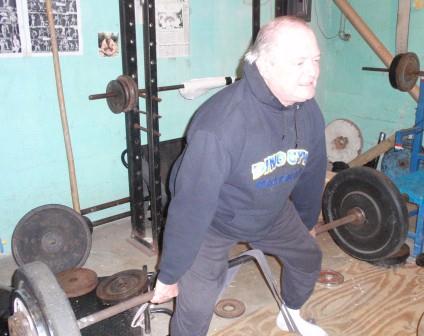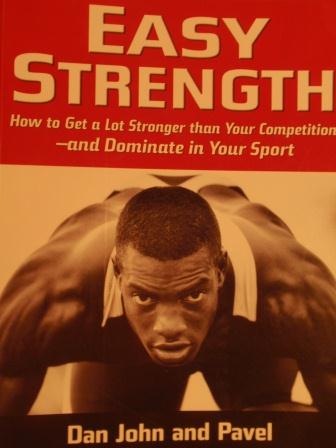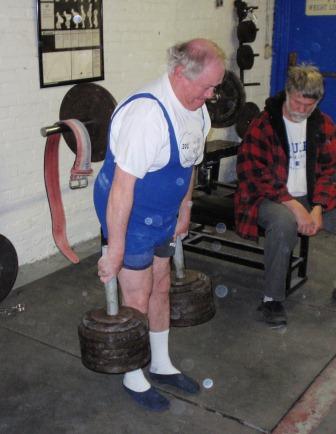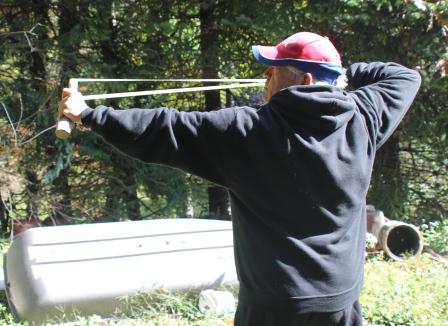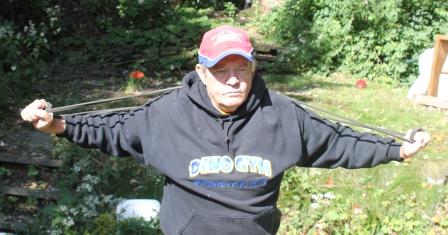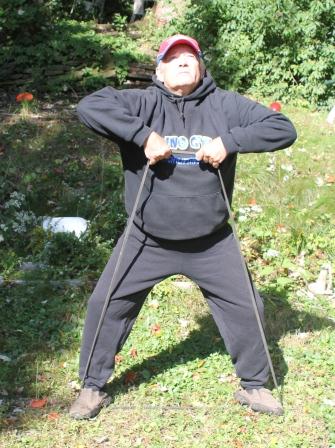by John McKean
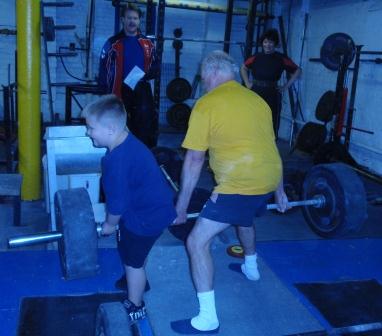
Andraes and John McKean completing a 2 Man Jefferson Lift. Scott and Kathy Schmidt are in the background cheering on what may be the first grandpa/grandson straddle lift on record.
This past Friday my phone rang and there was Art Montini’s name on the screen. Either the ole man finally figured how to dial out with his telephone, or something was “up” concerning his birthday meet at the Ambridge VFW on Sunday! Answering, I heard Art loudly, excitement in his voice, ask “Guess who I just heard from?!”
“Well,I hope it’s not from one of your replacement specialists, demanding a recall of totally abused new body parts!” I commented.
“Naw”, barked Art, “you know if any of those medical types gives me hassles about lifting, then I just find a new doctor!! But DALE FRIESZ is driving up from Virginia to lift!!”
Sure enough, come Sunday morning,after a much longer hospital stay than ever before (and there’s been a bunch in his recent history), in popped an ever smiling Dale, thinner (hates hospital food!) and sporting a 1″ diameter rod where his lower leg used to be. Dale cracked up when I informed him that it was about time someone finally showed that had skinnier calfs than me!! Later,Dale broke records that, in his words, “normal” guys had set (I told Dale that he was never exactly “normal”, but we quickly agreed that no one in the gym that morning was!!)
Then a long lost Jim Malloy marched in, growling all the way (with his usual, unprintable choice of colorful language!) how he was only lifting on his hobbled old body because Scott Schmidt dragged him over from Cleveland! Scott brought along beautiful wife Kathy to lift and help haul ole Jim,kicking & sputtering, into the VFW gym.
Denny Habecker traveled from across the state with a restored old time superstar -the always personable Barry Bryan !Barry has been troubled with knee and back problems stemming back to the 90s, but now feels ready to embark on a master lifter’s all-round career.
To make matters even more interesting, a brand new lifter, former “strongman” competitor Andy Root from nearby New Castle (PA), arrived with a whole team, and announced he would be attempting the Inman Mile! We told Andy to study Art,me, and the rest of this lineup of ” walking wrecks” present in the gym, because even on a classic, perfect weather Autumn morning if he tried that Mile he’d shortly appear ,at 31, just like the rest of us when we scraped him off the local high school track!!(he says he’ll save the Inman Mile for the “team challenge” in March! I told him Big Al not only will judge it, but probably PAY to see the event!!) So , Andy wisely reconsidered and started his all-round career more sensibly -his first lift was the Shoulder Drop !
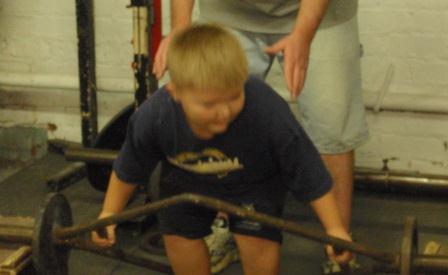
Youngest man in the contest, 6 year old Andraes McKean, starts out the festivities of our oldest US lifter's Annual Birthday Bash!
But the meet had everything: youngsters,open lifters,masters, females, teams, newbies, and interested onlookers! It was a personal thrill to have our youngest lifter, my grandson,6 year old Andraes, to set a few records and become part (some of the wags present claimed he did ALL the lifting!) of a grandson/grandfather team effort ( a first??)on deadlifts, hacks, and straddles!
Even ole Art did some dynamic overhead snatching and jerking, along with other records, that startled everyone with his speed & agility; maybe the docs did remove some old ligaments and tendons (muscles if he ever had any!), still under the 100 year warranty plan, and provided better bionics for this meet!!
MEET RESULTS:
Art’s Birthday Bash
October 16th, 2011
Ambridge VFW Club
Ambridge, PA
Meet Director: Art Montini
Lifts: Record Day
Officials (3 official system used on all lifts): Art Montini, Denny Habecker, Dennis Mitchell, John McKean, Dale Friesz, Scott Schmidt, Barry Bryan
Andraes McKean – 6 years old, 96.5# BW
45 KG Class, Male Junior 6-7 Age Group
Deadlift – Trap Bar (Trap Bar Deadlift): 29.55 KG, 65 lbs.
Deadlift – Fulton Bar (Two Hands Deadlift – 2 Inch Bar): 15.45 KG, 34 lbs.
Jefferson Lift – Fulton Bar (Straddle Deadlift – 2 Inch Bar): 15.45 KG, 34 lbs.
Vertical Bar Deadlift – 2″, 2 Bars (Two Vertical Bars – 2 inch rods): 21.82 KG, 48 lbs.
Vertical Bar Deadlift – 1 Bar, 2″, Right Hand (VB Lift – 2″ Rod): 10.91 KG, 24 lbs.
Angela Sweet – 31 years old, 129# BW
60 KG Class, Female Open Age Group
Bench Press – Feet on Floor (not USAWA lift): 61.36 KG 135 lbs.
Bench Press – Hands Together (Hands Together Bench Press): 50 KG, 110 lbs.
Bench Press – Reverse Grip (Reverse Grip Bench Press): 50 KG, 110 lbs.
Bench Press – Alternate Grip (Alternate Grip Bench Press): 50 KG, 110 lbs.
Jason Houk – 9 years old, 132# BW
60 KG Class, Male Junior 8-9 Age Group
Bench Press – Feet on Floor (not USAWA lift): 38.64 KG, 85 lbs.
Bench Press – Reverse Grip (Reverse Grip Bench Press): 36.36 KG, 80 lbs.
Curl – Strict (Strict Curl): 22.73 KG, 50 lbs.
Deadlift (not USAWA lift): 84.09 KG, 185 lbs.
Dale Friesz – 71 years old, 143.25# BW
70 KG Class, Mens Master 70-74 Age Group
Deadlift – Fingers, Little (Little Fingers Deadlift): 33.18 KG, 73 lbs.
Deadlift – Fingers, Index (Index Fingers Deadlift): 33.64 KG, 74 lbs.
Deadlift – Fingers, Ring (Ring Fingers Deadlift): 55.23 KG, 122 lbs.
Finger Lift – Right Middle Finger: 44.55 KG, 98 lbs.
Dennis Mitchell – 79 years old, 152# BW
70 KG Class, Mens Master 75-79 Age Group
Deadlift – No Thumbs (Two Hands Thumbless Deadlift): 85 KG, 187 lbs.
French Press (French Press): 18.18 KG, 40 lbs.
Deadlift – Stiff Legged (Stiff Leg Deadlift): 86.36 KG, 190 lbs.
Kathy Schmidt – 54 years old, 159# BW
75 KG Class, Womens Master 50-54 Age Group
Deadlift – Dumbbell, Right Arm (Right Hand Dumbbell Deadlift): 37.5 KG, 82 lbs.
Deadlift – Dumbbell, Left Arm (Left Hand Dumbbell Deadlift): 37.5 KG, 82 lbs.
Deadlift – 2 Dumbbells (Two Hands Dumbbells Deadlift): 82.5 KG, 182 lbs.
Deadlift – Trap Bar (Trap Bar Deadlift): 82.5 KG, 182 lbs.
John McKean – 65 years old, 164.75# BW
75 KG Class, Mens Master 65-69 Age Group
Deadlift – No Thumbs (Two Hands Thumbless Deadlift): 115.45 KG, 254 lbs.
Deadlift – Ciavattone Grip (Ciavattone Deadlift): 131.36 KG, 289 lbs.
Bench Press – Alternate Grip (Alternate Grip Bench Press): 61.36 KG, 135 lbs.
Bench Press – Reverse Grip (Reverse Grip Bench Press): 56.82 KG, 125 lbs.
Vertical Bar Deadlift – 1 Bar, 2″, Right Hand (VB Lift – 2″ Rod): 63.18 Kg, 139 lbs.
Vertical Bar Deadlift – 1 Bar, 2″, Left Hand (VB Lift- 2″ Rod): 56.36 KG, 124 lbs.
Deadlift – Fulton Bar (Two Hands Deadlift – 2″ Bar): 90.91 KG, 200 lbs.
Jefferson Lift – Fulton Bar (Straddle Deadlift – 2″ Bar): 90.91 KG, 200 lbs.
Deadlift – 2 Bars (Two Barbell Deadlift): 140.45 KG, 310 lbs.
Andy Root – 31 years old, 176# BW
80 KG Class, Mens Open Age Group
Lano Lift (not IAWA lift): 45.45 KG, 100 lbs.
Turkish Get Up (Turkish Get Up): 29.55 KG, 65 lbs.
Shoulder Drop (Shoulder Drop): 45.45 KG, 100 lbs.
Art Montini – 84 years old, 190# BW
90 KG Class, Mens Masters 80-84 Age Group
Snatch – Fulton Bar (Two Hands Snatch – 2″ Bar): 25 KG, 55 lbs.
Clean and Press – Fulton Bar (2 Hands Clean and Press – 2″ Bar): 31.82 KG, 70 lbs.
Clean and Jerk – Fulton Bar (2 Hands Clean and Jerk – 2″ Bar): 34.09 KG, 75 lbs.
Deadlift – Fulton Bar, Ciavattone Grip (2 Hand Fulton Deadlift): 72.73 KG, 160 lbs.
Deadlift – Fulton Bar (2 Hands Deadlift – 2″ Bar): 90.91 KG, 200 lbs.
Denny Habecker – 69 years old, 191# BW
90 KG Class, Mens Masters 65-69 Age Group
Push Press – From Rack (Push Press from Racks): 70.45 KG, 155 lbs.
Curl – Dumbbell, Cheat, Left Arm (Left Hand Dumbbell Cheat Curl): 20.45 KG, 45 lbs.
Clean & Jerk – Dumbbell, Left Arm (Left Hand DB Clean & Jerk): 25 KG, 55 lbs.
Clean & Jerk, – Dumbbell, Right Arm (Right Hand DB Clean & Jerk): 34.09 KG, 75 lbs.
Snatch – Dumbbell, Left Arm (Left Hand DB Snatch): 25 KG, 55 lbs.
Barry Bryan – 53 years old, 195# BW
90 KG Class, Mens Masters 50-54 Age Group
Vertical Bar Deadlift – 1 Bar, 2″, Left Hand (VB Lift – 2″ Rod): 70 KG, 154 lbs.
Vertical Bar Deadlift – 2 Bars, 2″ (Two VBs – 2″ Rod): 117.27 KG, 258 lbs.
Bench Press – Reverse Grip (Reverse Grip Bench Press): 93.18 KG, 205 lbs.
Guy Marcantino, Jr. – 35 years old, 230# BW
105 KG Class, Mens Open Age Group
Bench Press – Feet on Floor (not USAWA Lift): 186.36 KG, 410 lbs.
Bench Press – Reverse Grip (Reverse Grip Bench Press): 143.18 KG, 315 lbs.
Bench Press – Hands Together (Hands Together Bench Press): 136.36 KG, 300 lbs.
Scott Schmidt – 58 years old, 240# BW
110 KG Class, Mens Master 55-59 Age Group
Press – From Rack, Behind Neck (Press Behind Neck from Rack): 75 KG, 165 lbs.
Seated Press – From Rack, Behind Neck (Seated Press BN from Rack): 70 KG, 154 lbs.
Vertical Bar Deadlift – 1 Bar, 2″, Left Hand (VB Lift – 2″ Rod): 80 KG, 176 lbs.
Vertical Bar Deadlift – 1 Bar, 2″, Right Hand (VB Lift – 2″ Rod): 80 KG, 176 lbs.
Jim Malloy – 70 years old, 241.5# BW
110 KG Class, Mens Masters 70-74 Age Group
Bench – Feet in Air (Bench Press – Feet in Air): 86.36 KG, 190 lbs.
Curl – Strict (Strict Curl): 45.45 KG, 100 lbs.
Curl – Reverse Grip (Reverse Curl): 34.09 KG, 75 lbs.
Vertical Bar Deadlift – 1 Bar, 2″, Right Hand (VB Lift – 2″ Rod): 58.64 KG, 129 lbs.
Vertical Bar Deadlift – 1 Bar, 2″, Left Hand (VB Lift – 2″ Rod): 42.73 Kg, 94 lbs.
Andreas McKean and John McKean
75 KG Class, Mens Open Age Group
Deadlift – 2 Man (Two Person Team Deadlift): 70 KG, 154 lbs.
Jefferson Lift – 2 Man (Two Person Straddle Deadlift): 70 KG, 154 lbs.
Hack Lift – 2 Man (Two Person Hacklift): 70 KG, 154 lbs.
Angela Sweet and Andy Root
80 KG Class, Male/Female Open Age Group
Deadlift – 2 Person (Two Person Team Deadlift): 295.45 KG, 650 lbs.
Jason Houk and Guy Marcantino
105 KG Class, Mens Open Age Group
Deadlift – 2 Man (Two Person Team Deadlift): 184.09 KG, 405 lbs.
Andy Root and Guy Marcantino
105 KG Class, Mens Open Age Group
Hack Lift – 2 Man (Two Person Hacklift): 370.45 KG, 816 lbs.
